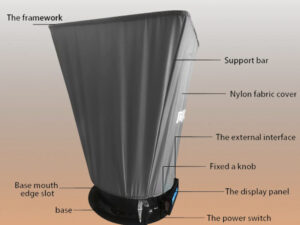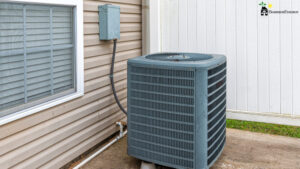Installer Verifications for Air-Conditioning:
Whenever you change out a ducted AC system or add ducted cooling to a property in California, a HERS Rater must perform certain air-conditioning verifications. Typically, AC is the last item we would HERS-verify on larger remodels and new construction projects because it’s often one of the last items installers complete. AC testing requires the installers to connect the system to a thermostat, charge the condenser with refrigerant (if applicable), and connect power to the system through the utility. There are three different air-conditioning verifications a field technician performs on AC systems: airflow, fan efficacy, and refrigerant charge. In this article, we will discuss the requirements for each type of verification!
Airflow: 
First off, airflow verifies the minimum required airflow rate of the cooling system, measured in cubic feet per minute (CFMs). It’s a mandatory measure that ensures proper airflow across the evaporator coil. Low airflow reduces the capacity of the system and may lead to premature failure of its components. Usually, we use a flow capture hood to measure the rate of airflow. We calculate the total system airflow by adding together the CFMs at each return.
After our diagnostic test, we will complete the airflow form(s) in either CalCERTS or CHEERS. In other words, we verify if the results are a pass or a fail, based on the system’s type and climate zone. There are some tips you can follow to be proactive before the airflow test. We recommend asking the installer if the filter is clean and if they turned the motor to full speed (if variable speed). Another way to ensure the system powers on to full speed is to establish if the indoor temperature is warm enough to trigger the system. On colder days, you may need to heat the building to at least seventy degrees prior to our arrival.
Airflow Remediation
Some factors that affect airflow include return duct sizing, duct design, cleanliness of the filter, obstructions, restricted vents, cleanliness of the evaporator coil, motor speed, and the blower wheel. If remediation of the system is needed, these are the first items that we will look at. All of these factors can contribute to static pressure, which is resistance to airflow within the system. When dealing with existing ductwork, it may be harder to know the details of the ductwork.
Don’t panic if a system doesn’t pass an airflow test. We will do our best to help diagnose the cause so that the installer can perform remediation on the system. Remedial actions may involve any of the previously mentioned factors of airflow. After remediation, we must re-verify and document a passing result. If the installer still cannot get the system to pass the minimum airflow requirements, they can install an Occupant Controlled Smart Thermostat (OCST). However, we must first show that the installer has tried all possible actions to fix the system.
Fan Efficacy / Fan Watt Draw:
Fan efficacy is always triggered along with airflow and is performed simultaneously. It verifies the efficiency of the fan motor by measuring how many Watts move one CFM of air. The formula for calculating fan efficacy is Watts/CFM. We calculate fan efficacy by taking a Fan Watt Draw reading during the airflow test. A Fan Watt Draw meter measures the amount of Watts the system produces. Then, we can follow the fan efficacy formula and verify if it is below the target value. Target values depend on system type as well as climate zone.
Refrigerant Charge:
Lastly, refrigerant charge is triggered when air conditioners are altered by the installation of refrigerant-containing components. The technician performing refrigerant charge verification must have an EPA 608 Certification of Level II or better. EPA 608 Certification allows the field technician to operate with refrigerant-containing components which are classified as Ozone Depleting Substances by the Environmental Protection Agency.
 Simply put, it’s a verification of how much refrigerant is in the outdoor condenser. All condensers are factory charged with enough refrigerant for ten feet of line-set. In those cases when the installer doesn’t change the amount of refrigerant, it can be verified by reading the factory charge amount on the condenser’s face plate. When an installer adds more refrigerant to a system, the technician measures the amount of refrigerant by reading temperature and pressure. Not enough refrigerant means the system is undercharged, which reduces system efficiency and can cause the compressor to overheat. Too much refrigerant reduces system efficiency by overworking the system and can lead to compressor failure.
Simply put, it’s a verification of how much refrigerant is in the outdoor condenser. All condensers are factory charged with enough refrigerant for ten feet of line-set. In those cases when the installer doesn’t change the amount of refrigerant, it can be verified by reading the factory charge amount on the condenser’s face plate. When an installer adds more refrigerant to a system, the technician measures the amount of refrigerant by reading temperature and pressure. Not enough refrigerant means the system is undercharged, which reduces system efficiency and can cause the compressor to overheat. Too much refrigerant reduces system efficiency by overworking the system and can lead to compressor failure.
Performing the Refrigerant Charge Verification
HERS Raters perform a refrigerant charge test by using gauges to measure pressure and temperature at various points in the system. Outdoor temperatures must be at least 55°F or the refrigerant can freeze during the test. The weigh-in method is an alternative that a Rater can utilize when a typical refrigerant charge cannot occur, such as when the temperature is below 55°F or on mini-split systems. In those instances, the HERS Rater may be present for the installer’s refrigerant charge and can verify the amount of refrigerant by reading a digital scale.
Need Help with Air-Conditioning Verifications?:
BarrierEnergy is a HERS Rating company that services Santa Barbara County, San Luis Obispo County, Ventura County, and parts of LA County. We have over a decade of experience with AC requirements, and can help you pass your final inspection with flying colors! Contact us or get a free quote today. Also, subscribe to our blog for more useful content.


Recent Comments